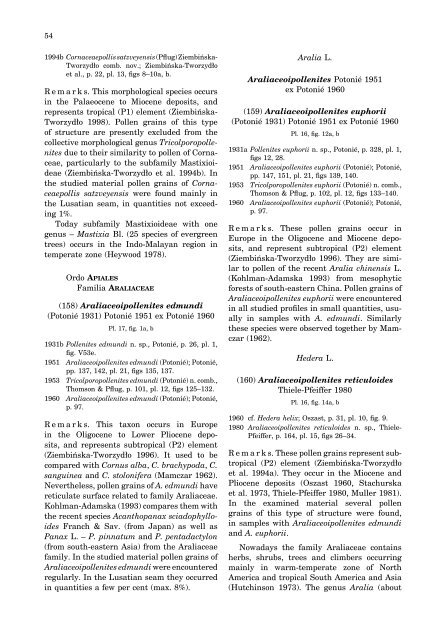Middle Miocene palynoflora of the Legnica lignite deposit complex ...
Middle Miocene palynoflora of the Legnica lignite deposit complex ...
Middle Miocene palynoflora of the Legnica lignite deposit complex ...
Create successful ePaper yourself
Turn your PDF publications into a flip-book with our unique Google optimized e-Paper software.
54<br />
1994b Cornaceaepollis satzveyensis (Pfl ug) Ziembińska-<br />
Tworzydło comb. nov.; Ziembińska-Tworzydło<br />
et al., p. 22, pl. 13, fi gs 8–10a, b.<br />
R e m a r k s. This morphological species occurs<br />
in <strong>the</strong> Palaeocene to <strong>Miocene</strong> <strong>deposit</strong>s, and<br />
represents tropical (P1) element (Ziembińska-<br />
Tworzydło 1998). Pollen grains <strong>of</strong> this type<br />
<strong>of</strong> structure are presently excluded from <strong>the</strong><br />
collective morphological genus Tricolporopollenites<br />
due to <strong>the</strong>ir similarity to pollen <strong>of</strong> Cornaceae,<br />
particularly to <strong>the</strong> subfamily Mastixioideae<br />
(Ziembińska-Tworzydło et al. 1994b). In<br />
<strong>the</strong> studied material pollen grains <strong>of</strong> Cornaceaepollis<br />
satzveyensis were found mainly in<br />
<strong>the</strong> Lusatian seam, in quantities not exceeding<br />
1%.<br />
Today subfamily Mastixioideae with one<br />
genus – Mastixia Bl. (25 species <strong>of</strong> evergreen<br />
trees) occurs in <strong>the</strong> Indo-Malayan region in<br />
temperate zone (Heywood 1978).<br />
Ordo APIALES<br />
Familia ARALIACEAE<br />
(158) Araliaceoipollenites edmundi<br />
(Potonié 1931) Potonié 1951 ex Potonié 1960<br />
Pl. 17, fi g. 1a, b<br />
1931b Pollenites edmundi n. sp., Potonié, p. 26, pl. 1,<br />
fi g. V53e.<br />
1951 Araliaceoipollenites edmundi (Potonié); Potonié,<br />
pp. 137, 142, pl. 21, fi gs 135, 137.<br />
1953 Tricolporopollenites edmundi (Potonié) n. comb.,<br />
Thomson & Pfl ug, p. 101, pl. 12, fi gs 125–132.<br />
1960 Araliaceoipollenites edmundi (Potonié); Potonié,<br />
p. 97.<br />
R e m a r k s. This taxon occurs in Europe<br />
in <strong>the</strong> Oligocene to Lower Pliocene <strong>deposit</strong>s,<br />
and represents subtropical (P2) element<br />
(Ziembińska-Tworzydło 1996). It used to be<br />
compared with Cornus alba, C. brachypoda, C.<br />
sanguinea and C. stolonifera (Mamczar 1962).<br />
Never<strong>the</strong>less, pollen grains <strong>of</strong> A. edmundi have<br />
reticulate surface related to family Araliaceae.<br />
Kohlman-Adamska (1993) compares <strong>the</strong>m with<br />
<strong>the</strong> recent species Acanthopanax sciadophylloides<br />
Franch & Sav. (from Japan) as well as<br />
Panax L. – P. pinnatum and P. pentadactylon<br />
(from south-eastern Asia) from <strong>the</strong> Araliaceae<br />
family. In <strong>the</strong> studied material pollen grains <strong>of</strong><br />
Araliaceoipollenites edmundi were encountered<br />
regularly. In <strong>the</strong> Lusatian seam <strong>the</strong>y occurred<br />
in quantities a few per cent (max. 8%).<br />
Aralia L.<br />
Araliaceoipollenites Potonié 1951<br />
ex Potonié 1960<br />
(159) Araliaceoipollenites euphorii<br />
(Potonié 1931) Potonié 1951 ex Potonié 1960<br />
Pl. 16, fi g. 12a, b<br />
1931a Pollenites euphorii n. sp., Potonié, p. 328, pl. 1,<br />
fi gs 12, 28.<br />
1951 Araliaceoipollenites euphorii (Potonié); Potonié,<br />
pp. 147, 151, pl. 21, fi gs 139, 140.<br />
1953 Tricolporopollenites euphorii (Potonié) n. comb.,<br />
Thomson & Pfl ug, p. 102, pl. 12, fi gs 133–140.<br />
1960 Araliaceoipollenites euphorii (Potonié); Potonié,<br />
p. 97.<br />
R e m a r k s. These pollen grains occur in<br />
Europe in <strong>the</strong> Oligocene and <strong>Miocene</strong> <strong>deposit</strong>s,<br />
and represent subtropical (P2) element<br />
(Ziembińska-Tworzydło 1996). They are similar<br />
to pollen <strong>of</strong> <strong>the</strong> recent Aralia chinensis L.<br />
(Kohlman-Adamska 1993) from mesophytic<br />
forests <strong>of</strong> south-eastern China. Pollen grains <strong>of</strong><br />
Araliaceoipollenites euphorii were encountered<br />
in all studied pr<strong>of</strong>i les in small quantities, usually<br />
in samples with A. edmundi. Similarly<br />
<strong>the</strong>se species were observed toge<strong>the</strong>r by Mamczar<br />
(1962).<br />
Hedera L.<br />
(160) Araliaceoipollenites reticuloides<br />
Thiele-Pfeiffer 1980<br />
Pl. 16, fi g. 14a, b<br />
1960 cf. Hedera helix; Oszast, p. 31, pl. 10, fi g. 9.<br />
1980 Araliaceoipollenites reticuloides n. sp., Thiele-<br />
Pfeiffer, p. 164, pl. 15, fi gs 26–34.<br />
R e m a r k s. These pollen grains represent subtropical<br />
(P2) element (Ziembińska-Tworzydło<br />
et al. 1994a). They occur in <strong>the</strong> <strong>Miocene</strong> and<br />
Pliocene <strong>deposit</strong>s (Oszast 1960, Stachurska<br />
et al. 1973, Thiele-Pfeiffer 1980, Muller 1981).<br />
In <strong>the</strong> examined material several pollen<br />
grains <strong>of</strong> this type <strong>of</strong> structure were found,<br />
in samples with Araliaceoipollenites edmundi<br />
and A. euphorii.<br />
Nowadays <strong>the</strong> family Araliaceae contains<br />
herbs, shrubs, trees and climbers occurring<br />
mainly in warm-temperate zone <strong>of</strong> North<br />
America and tropical South America and Asia<br />
(Hutchinson 1973). The genus Aralia (about

















